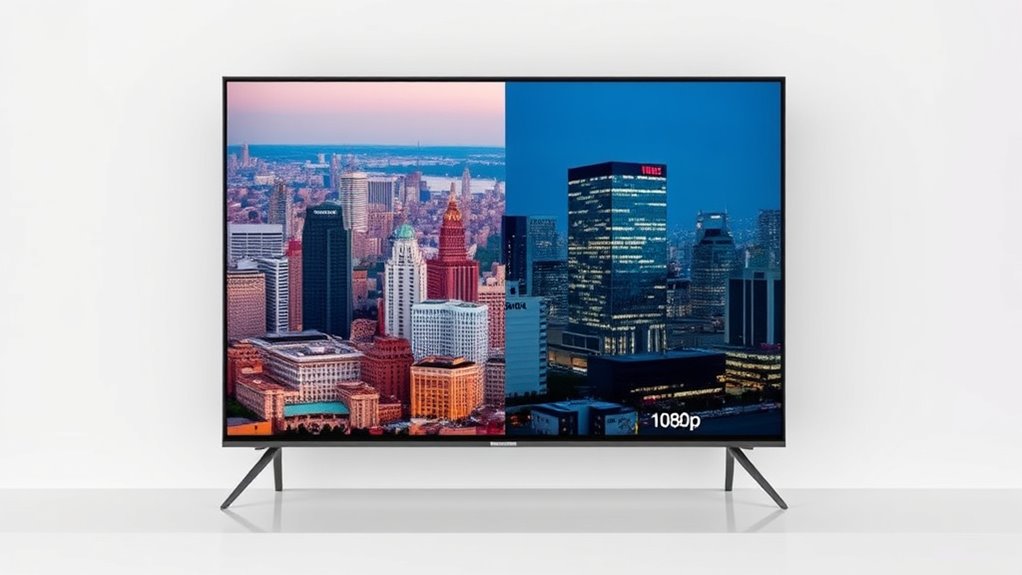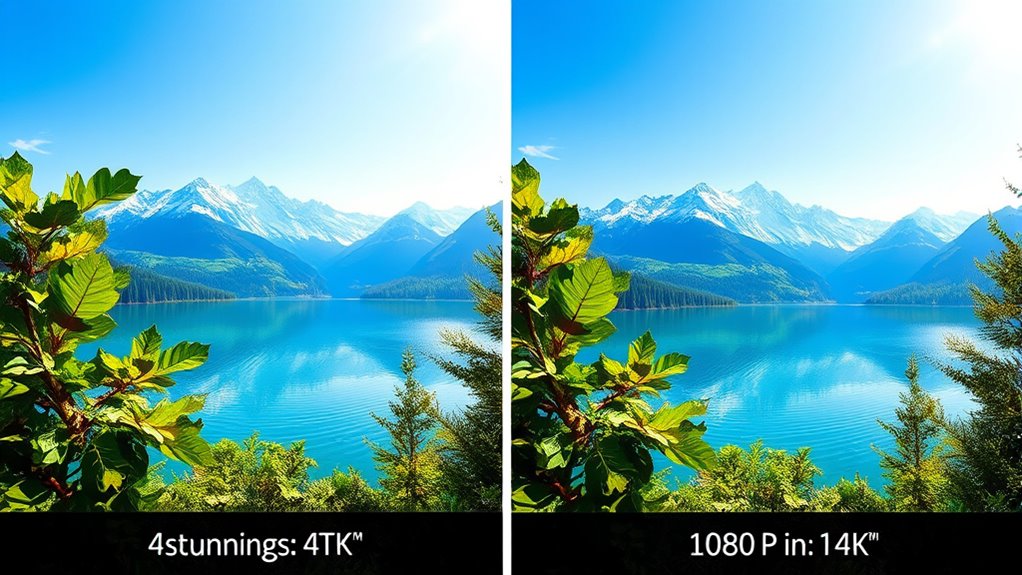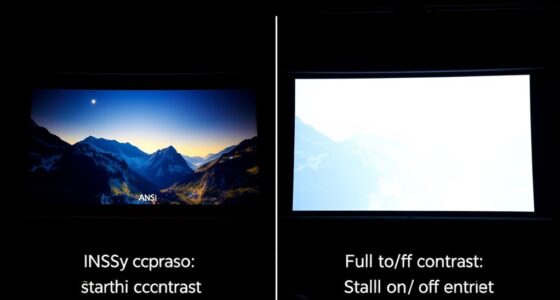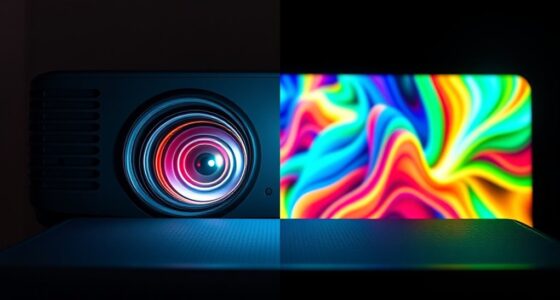If you’re trying to understand 4K versus 1080p, think of 4K as having four times the pixels of 1080p, which means sharper detail on larger screens and when close up. While 4K offers more clarity, it also demands more processing power and storage. Your choice depends on screen size, viewing distance, and what you’ll use the display for. Keep going to uncover how these factors can help you pick the perfect display for your needs.
Key Takeaways
- 4K offers four times the pixel count of 1080p, providing clearer, more detailed images.
- Larger screens and closer viewing distances benefit most from 4K resolution.
- 4K enhances visual quality but requires more processing power and compatible hardware.
- 1080p may suffice for smaller screens or distant viewing, balancing quality and performance.
- Content compression and video settings influence the final image quality across both resolutions.
Understanding Resolution: What Do 4K and 1080p Mean?

Understanding resolution is crucial because it determines how sharp and detailed your images appear on screen. When comparing 4K and 1080p, you’re fundamentally looking at the number of pixels each display contains. 4K offers four times the pixels of 1080p, resulting in clearer, more detailed images. However, higher resolution also means more data to process, which impacts video compression techniques used to stream or store content efficiently. Additionally, screen refresh rates play a role in how smooth motion appears, but resolution primarily affects image clarity. Choosing between 4K and 1080p depends on your viewing needs and hardware capabilities, with higher resolutions demanding more from your device. Knowledge of video compression techniques can help you understand how content is optimized for different resolutions, ensuring a better viewing experience.
Choosing the Right Display: Factors to Consider When Deciding Between 4K and 1080p

When choosing between 4K and 1080p displays, there are several key factors to take into account to guarantee you select the best option for your needs. Your screen size plays a significant role; larger screens benefit from 4K resolution because it provides sharper details and reduces pixelation. Consider your usual viewing distance as well—if you sit close to your screen, a 4K display offers a clearer, more immersive experience. For smaller screens or if you sit farther away, 1080p might suffice without noticeable quality loss. Think about how you’ll use the display: gaming, movies, or productivity. Matching your screen size and viewing distance with your intended use helps you make an informed decision between 4K and 1080p. Additionally, understanding the contrast ratio of a projector can dramatically influence your viewing experience, especially in dark scenes.
Frequently Asked Questions
How Does Resolution Impact Gaming Performance and Frame Rates?
Higher resolution, like 4K, demands more from your GPU, which can lower your frame rates and increase input lag if your system isn’t powerful enough. A higher refresh rate helps smooth out gameplay, but it can also be affected by resolution. If you wanna optimize gaming performance, balance resolution with your hardware’s capabilities, and choose a monitor with a high refresh rate to minimize input lag and improve overall experience.
Are 4K Displays More Expensive to Maintain Than 1080P?
You’ll find that 4K displays are generally more expensive to maintain than 1080p ones. They often have higher initial costs, and their increased energy consumption—around 30% more—adds to ongoing expenses. A recent study shows that 4K screens use considerably more power, which can impact your monthly bills. So, if budget and energy efficiency matter, 1080p options might be more cost-effective for you long-term.
Can I Upgrade My Current Device to Support 4K or 1080P?
You can upgrade your device to support 4K or 1080p, but it depends on your device’s compatibility and available upgrade options. Check if your device has a compatible graphics card, HDMI port, and sufficient processing power for 4K. If not, you might need to upgrade components or consider a new device. Always review manufacturer guidelines to verify your upgrade options are feasible and won’t void warranties.
Which Resolution Is Better for Virtual Reality Experiences?
For VR experiences, 4K resolution offers better VR immersion and resolution fidelity, making visuals sharper and more realistic. You’ll notice more detail and less pixelation, which enhances comfort during extended use. However, guarantee your device can handle the higher demands. If you prioritize visual quality and have a powerful system, 4K is the better choice. Otherwise, 1080p still provides a solid, immersive experience for most VR users.
How Does Screen Size Influence the Perception of Resolution Quality?
Think of your screen as a canvas; larger screens make resolution seem less sharp, like an impressionist painting compared to a hyper-realistic photo. As screen size increases, pixel density drops unless you scale up resolution, and your viewing distance becomes essential. The farther you sit, the less you’ll notice the difference in clarity. To keep images crisp, match larger screens with higher resolutions or sit closer.
Conclusion
Choosing between 4K and 1080p is like picking the right gear for your adventure—you want clarity without unnecessary baggage. If you crave stunning detail and have the space, 4K is your trusty companion. But if you prefer a smooth ride on a smaller budget, 1080p still gets the job done. Whichever you choose, your viewing experience will be brighter than a lighthouse guiding ships home. Make your decision and enjoy the journey!









